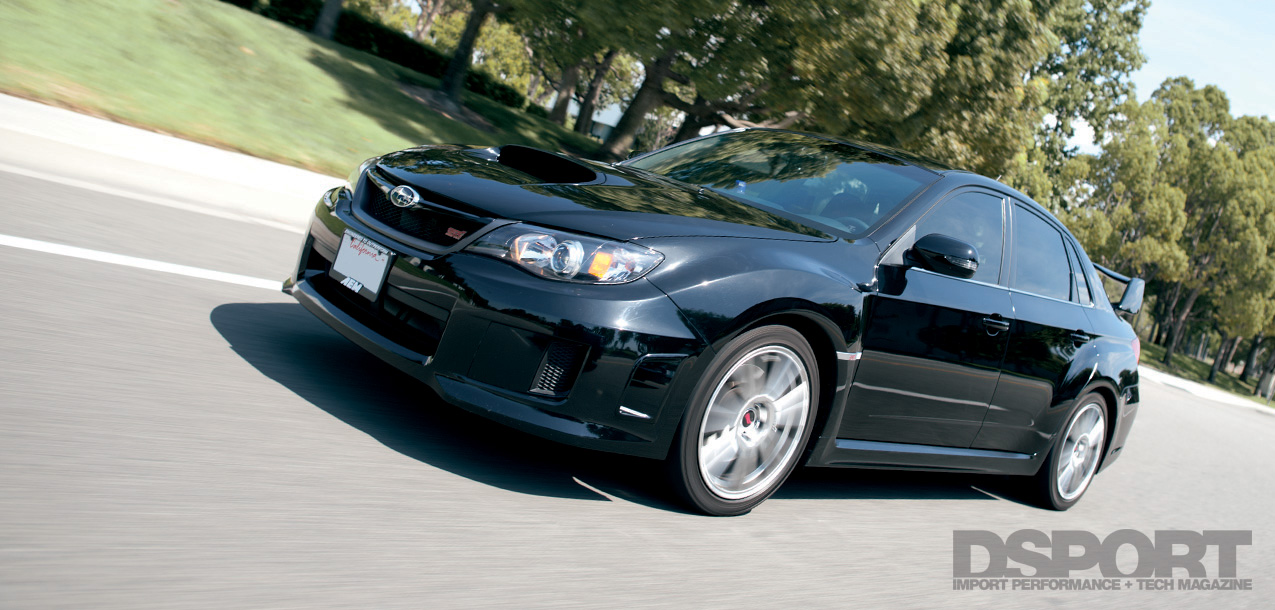The Dyno
Baseline
On the Dynapack all-wheel drive dynamometer at Crawford Performance in Oceanside, California, our T&T STI managed a baseline horsepower rating of 268.9 WHP at 6,109 RPM. Maximum available torque peaked at 298.3 lb-ft at 3,578 RPM. The reading was consistent with the last numbers achieved on the same dynamometer in STI T&T part 1 so we proceeded with the installations as planned.
268.9 WHP @ 6,109 RPM
298.3 LB-FT TQ @ 3,578 RPM
Dynapack
Test 1 AEM Intake
After tuning, the AEM intake offered a 5.0-to-6.0-horsepower increase across much of the powerband. We used the COBB AP to regulate boost to the same level. Peak torque also increased 7.7 lb-ft as a result of the intake system’s increased intake flow.
274.7 WHP @ 5,971 RPM
306.0 LB-FT TQ @ 3,277 RPM
Test 2 SPT Cat-back Exhaust
The SPT exhaust system was good for a 9.0 wheel horsepower increase in several areas of the powerband, including peak horsepower produced. Additionally, the exhaust also offers more power in the mower regions of the powerband before 3,000 RPM.
283.7 WHP @ 6,098 RPM
304.8 LB-FT TQ @ 3,392 RPM
Test 3 Crawford Performance Downpipe
The Crawford Performance downpipe offered the gretest increase in peak horsepower, manging a 16.6 whp increase at approximately 5,000 RPM. Torque also increased significantly, but the power graph hinted at detonation in the upper RPM regions, most likely due to the heat-soaked factory intercooler.
300.3 WHP @ 5,251 RPM
331.1 LB-FT TQ @ 3,300 RPM
On the Dynapack all-wheel drive dynamometer at Crawford Performance in Oceanside, California, our T&T STI managed a baseline horsepower rating of 268.9 WHP at 6,109 RPM. Maximum available torque peaked at 298.3 lb-ft at 3,578 RPM. The reading was consistent with the last numbers achieved on the same dynamometer in STI T&T part 1 so we proceeded with the installations as planned.
Due to the placement of the factory intake box, the installation of the AEM Induction intake system was straightfoward. After the intake system installation, tuner Bill Knose fired up the Dynapack dynamometer and tuned the existing fuel and ignition maps for the modified MAF signal via the Cobb AP. After a few tuning pulls to maintain boost levels and safe A/F ratios, the intake revealed a 5.8 WHP increase in peak power. Some spots in the powerband showed a 8- to 10-wheel horsepower increase. After tuning the Cobb AP with the AEM intake in place, the peak figures checked in at 268.9 wheel horsepower and 298.3 lb-ft of torque.
Next, the STI was taken off the Dynapack hubs and placed on the lift for the exhaust installation. As the SPT exhaust system was designed by Subaru engineers, it had an excellent fit and finish. With the SPT exhaust in place and the STI back on the dynamometer hubs, Knose again optimized fuel and ignition maps with a keen eye toward maintaining the same boost level and a conservative “pump-gas friendly” A/F ratio target. Under those parameters, peak horsepower production increased to 274.7 whp at 5,971 RPM. The bulk of the power production appeared in the 4,200- to 5,300-RPM range with gains again ranging from 6.0- to 10-horsepower. An additional 7.7 lb-ft of torque was also produced, bringing peak torque numbers up to 306.0 whp seen at 3,277 RPM.
The last item installed was the Crawford Performance downpipe. The EJ257 downpipe flange has an inherently tricky bolt to get to but installation went well otherwise without a hitch. As promised, the downpipe fit perfectly with the aftermarket SPT exhaust system. Knose spent a little more time with the Cobb AP to fine-tune the fuel, ignition, boost and A/F ratio parameters within specifications. On the dyno, the downpipe revealed significant horsepower gains but the analysis of the power curve proved the engine was beginning to experience detonation. Knose proceeded to soften the maps to a safer tune. Even with conservative timing and fuel maps in place, the Crawford downpipe registered impressive power and torque numbers to the tune of 300.3 peak wheel horsepower and a staggering 331.1 lb-ft of torque, an increase of 26.3 lb-ft at the 3,300 RPM torque sweet spot of the EJ257 engine.
SIDEBAR: BEAT THE HEAT
The Subaru STI’s top-mounted intercooler allows for a short path from the turbo to the throttle body, but sacrifices its ability to cool the charge air. This is due to its location and the relative lack of airflow reaching the core compared to a similarly-sized front-mounted intercooler. In the case of our Test & Tune STI, the engine showed little to no gain at the upper RPM regions of the powerband with the upgraded downpipe. This is most likely due to the factory intercooler failing to cool charge air adequately. High intake air temperatures can contribute to knock. Because the EJ257 has built-in knock protection, the ECU’s response to detonation is to retard timing to less aggressive levels. In the end, the removal of ignition timing manifests as a loss in power on the dyno graph, especially in the upper RPM regions where detonation was more likely prevalent. In our next Test & Tune installment on the Subaru, we’ll explore the benefits of a front-mounted intercooler kit.







